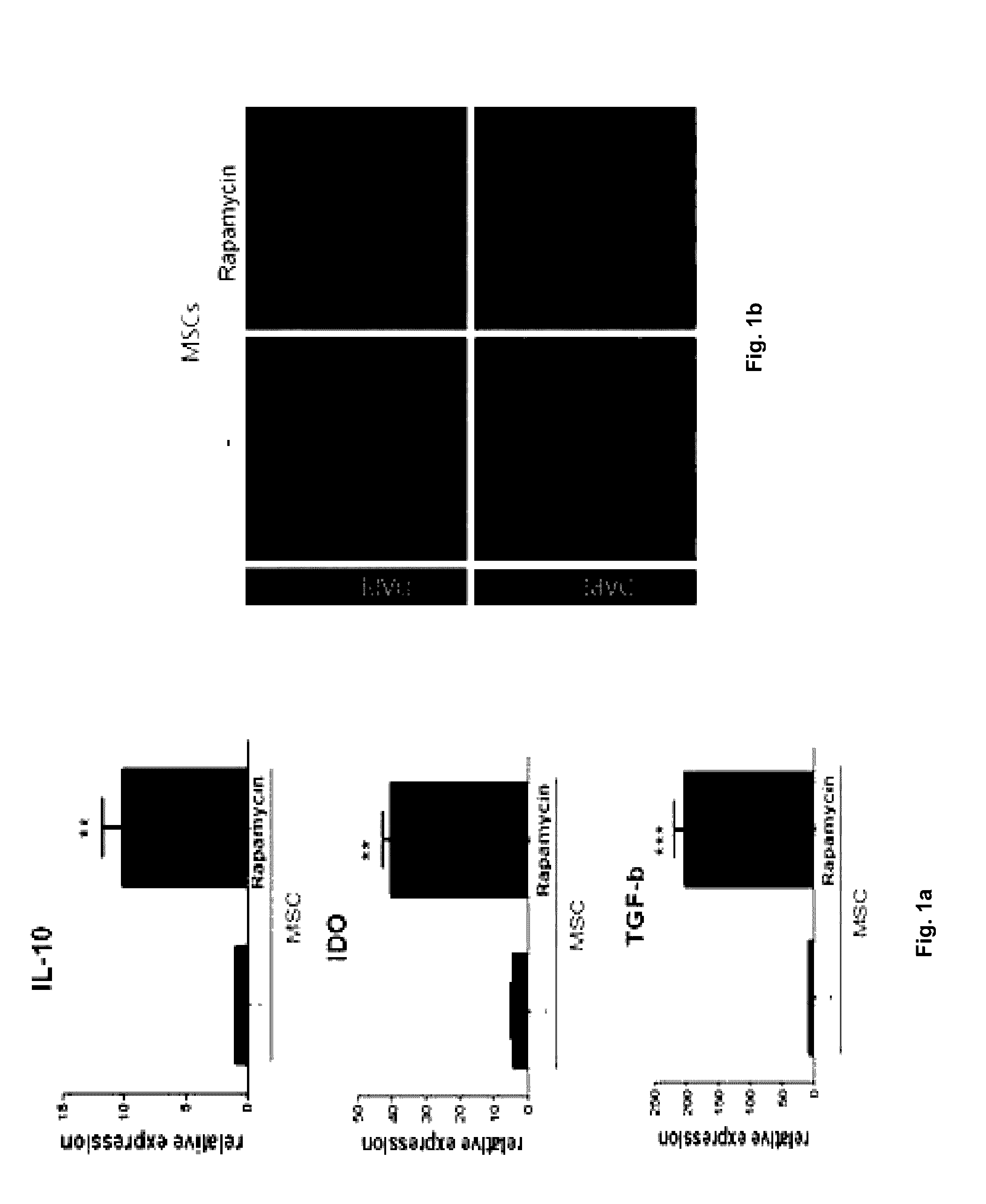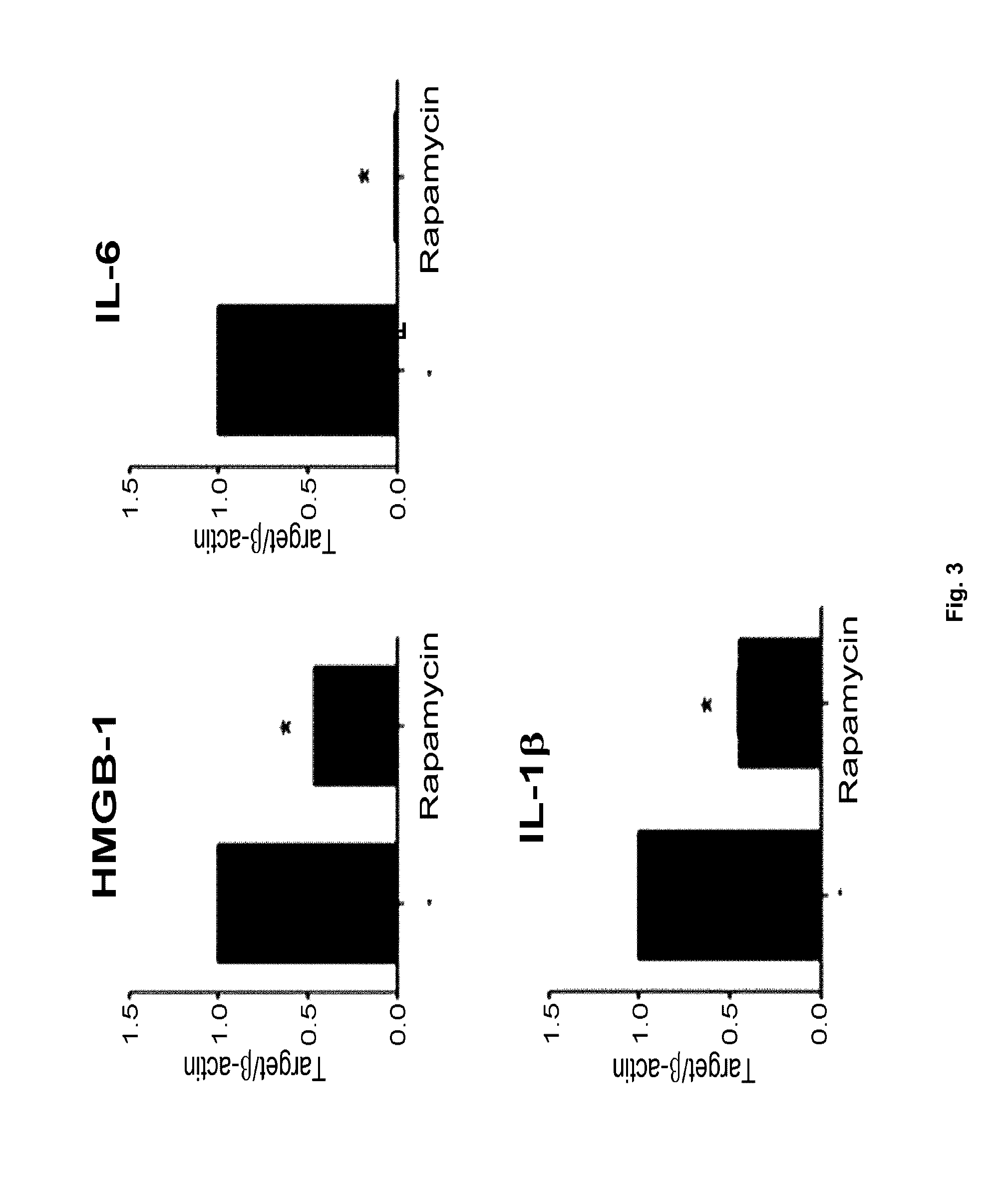Mtor/stat3 signal inhibitor-treated mesenchymal stem cell having immunomodulatory activity, and cell therapy composition comprising same, for preventing or treating immune disorders
a technology of mesenchymal stem cells and signal inhibitors, which is applied in the direction of skeletal/connective tissue cells, immunological disorders, peptide/protein ingredients, etc., can solve the problems of limited treatment options, almost no research on the preparation of stem cells with excellent treatment effects, etc., and achieves increased expression, decreased expression, and increased expression. effect of ido
- Summary
- Abstract
- Description
- Claims
- Application Information
AI Technical Summary
Benefits of technology
Problems solved by technology
Method used
Image
Examples
example 1
Analysis of Changes in Expression of Genes Associated with Immunomodulatory Activity in Rapamycin-Treated Mesenchymal Stem Cells
[0075] Isolation of Mesenchymal Stem Cells from Peripheral Blood and Culturing Thereof
[0076]Monocytes were isolated from peripheral blood using Ficoll-paque, cultured in Dulbecco's modified Eagle's medium (DMEM) containing 20% fetal bovine serum for 6 days, and the suspension cells floated to the top were removed, and subcultures were proceeded using only those cells adhered to the cell culture plates at 37° C. (5% CO2). The mesenchymal stem cells were isolated from peripheral blood and cultured while replacing the culture broth at intervals of 3 days.
[0077] Isolation of Mesenchymal Stem Cells from Adipose Tissue and Culturing Thereof
[0078]The adipose tissues obtained by liposuction or surgical operation were washed 10 times with PBS containing penicillin-streptomycin to remove blood and impurities, and the tissues were minced to have a weight of from 0.2 g...
example 2
Analysis of the Inhibitory Effect of Etiological Th17 Cell Growth in Rapamycin-Treated Mesenchymal Stem Cells
[0083]The present inventors examined the T cell proliferation by thymidine treatment for the investigation of the inhibitory effect of rapamycin-treated mesenchymal stem cells on T cell proliferation. First, mouse CD4+T cells (1105) and mesenchymal stem cells (1104) were added into a 96-well plate in a 1:10 ratio and co-cultured at 37° C. for 3 days. After 3 days, the T cell proliferation was examined by thymidine treatment and thereby analyzed the inhibitory effect against T cell proliferation.
[0084]As a result of the analysis, it was confirmed that the inhibitory effect of mesenchymal stem cells on T cell proliferation was further decreased by the rapamycin-treated mesenchymal stem cells (FIG. 2).
example 3
Analysis of the Inhibitory Effect of Rapamycin-Treated Mesenchymal Stem Cells Against Inflammatory Factors and Tumor Factors
[0085]The mesenchymal stem cells isolated and cultured in were treated with rapamycin, respectively, and the changes in the expression of High-mobility group protein B1 (HMGB-1), IL-6, and IL-1β, which are genes associated with inflammatory factors and tumor factors. First, in a condition of 60 mm dish, for the adipose tissue-derived mesenchymal stem cells, the mesenchymal stem cells in the amount of 5105 cells which were treated with 100 nM rapamycin and cultured at 37° C. were used. In particular, the mesenchymal stem cells not treated with rapamycin were used as a control, and the expression level of the genes having immunomodulatory activity in rapamycin-treated mesenchymal stem cells was analyzed using a real time PCR method.
[0086]As a result of the analysis, as shown in FIG. 3, the mesenchymal stem cells in the group treated with rapamycin showed a signi...
PUM
| Property | Measurement | Unit |
|---|---|---|
| temperature | aaaaa | aaaaa |
| weight | aaaaa | aaaaa |
| temperature | aaaaa | aaaaa |
Abstract
Description
Claims
Application Information
 Login to View More
Login to View More - R&D
- Intellectual Property
- Life Sciences
- Materials
- Tech Scout
- Unparalleled Data Quality
- Higher Quality Content
- 60% Fewer Hallucinations
Browse by: Latest US Patents, China's latest patents, Technical Efficacy Thesaurus, Application Domain, Technology Topic, Popular Technical Reports.
© 2025 PatSnap. All rights reserved.Legal|Privacy policy|Modern Slavery Act Transparency Statement|Sitemap|About US| Contact US: help@patsnap.com



